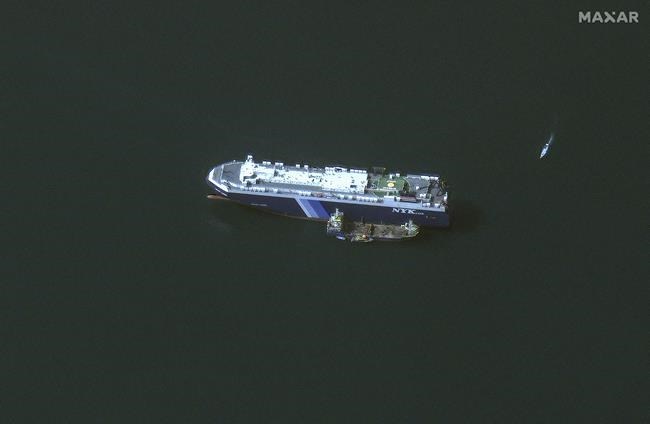MONTREAL — Canadian shippers and consumers could soon be feeling the ripple effect of attacks on cargo vessels in the Red Sea, as freight rates rise and delivery times lengthen.
Shipping firms across the globe are turning away from the key trade corridor after Houthi militants in Yemen stepped up attacks on commercial boats in the region to protest against Israel's military campaign in the Gaza Strip.
Shipping giant Maersk said Friday it plans to continue rerouting all vessels bound for the Suez Canal around Africa's Cape of Good Hope "for the foreseeable future," following an earlier pause through the waterway linking Asia and Europe.
Other shipping companies including MSC — the world's biggest container shipper — Hapag-Lloyd and Evergreen have also suspended passage through the Red Sea's Bab el-Mandeb Strait, which has been the focal point of dozens of attempted missile and drone strikes against cargo boats.
The route change adds about 10 days and hundreds of thousands of dollars in extra fuel and labour costs per trip to Western Europe from Southeast Asia, resulting in potential price increases for wholesale and retail products.
Europe and the Middle East will feel the impact most directly, says Université Laval business professor Yan Cimon. But consumer goods and some manufacturing parts destined for Canada also come via the canal, which carries roughly a third of global container traffic.
"It's something Canadians will see. It will have an impact on our collective wallets," Cimon said. "Obviously we do significant trade with Europe, and we also import some commodities from Asia that may go through Suez.
"The shippers themselves will see also a big strain on their shipping capacity, because as ships are tied up through longer routes, they cannot be used on other routes," he said, noting that a scarcity of shipping containers could increase prices further.
Global container shipping rates surged 61 per cent in the past week alone, according to data from Drewry, a maritime industry research firm. Since Nov. 30, global rates have surged 93 per cent to US$2,670 per 40-foot container from US$1,382.
Just how the tighter shipping capacity and higher fees will filter down to consumers remains unclear.
"We're going to feel it differently and maybe over a longer period of time," Cimon said, noting that shipping contracts come up for renegotiation frequently — typically every three to 12 months.
"We are in a worldwide economic slowdown and awash in oil production," said Barry Prentice, who heads the University of Manitoba's transport institute.
"But one cannot take out an extremely important shipping route like the Suez without disrupting the normal flows."
The diverted vessels also throw a wrench into the logistics gears of importers, wholesalers and ultimately retailers.
"What we will see is a delay in the arrival of the cargo that is already on those ships," said Beth Rooney, port director at the Port Authority of New York and New Jersey.
"If they want to get to a spring sale, they'll look to push up the manufacturing and the shipping from overseas."
Meanwhile, a severe drought in Panama has further amplified the impact of the Red Sea no-go zone.
Many shipping services between Asia and North America's east coast had recently switched to the Suez Canal, instead of travelling the usual route across the Pacific Ocean and through the Panama Canal.The drought has sapped the canal of water, which is used to raise and lower ships at a dozen locks, prompting officials to cut the number of boats they let through the Central American waterway.
Fewer slots have boosted tolls and caused bottlenecks at the critical trade conduit between the Atlantic and Pacific Oceans and pushed some oil tankers and container ships to steer clear of the back-up by taking longer routes — typically via the Suez Canal.
Now, the Red Sea crisis is adding to those shipping costs. Since the beginning of December, rates rose 86 per cent for freight shipped from Southeast Asia to U.S. East Coast ports, and two-thirds from North Asia, according to data provider S&P Global Platts. Those shippers already faced greater expenses from either higher charges in Panama or longer routes via the Suez Canal.
Even for Pacific cargo bound for the U.S. West Coast, rates jumped 81 per cent from Southeast Asia and 78 per cent from North Asia, illustrating the knock-on effects across the shipping world.
"Canada is, you could say, somewhat lucky that it's geographically dependent on North American and other global supply chains. Yet that doesn't mean we're not at risk," said Cimon.
Since late October, Iran-backed Houthi militants have launched scores of one-way attack drones and missiles at commercial vessels transiting the Red Sea. U.S. Navy warships have also intercepted ballistic missiles the Pentagon said were headed toward Israel.
Houthis attacked an MSC container ship on Dec. 26 and a Maersk ship on Sunday — days after the company had resumed sailing in the area. No injuries were reported.
In response to earlier strikes, the U.S. announced Operation Prosperity Guardian on Dec. 18. The U.S., Canada and other states are part of the heightened military presence in the perilous strait, with some countries sending additional ships to the southern Red Sea to protect merchant vessels.
However, the Houthis have continued to launch missiles and attack drones, prompting the White House and allies to issue what amounted to a final warning Wednesday to cease their assault on vessels in the Red Sea or face potential targeted military action.
This report by The Canadian Press was first published Jan. 5, 2024.
— With files from The Associated Press
Christopher Reynolds, The Canadian Press



